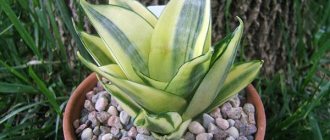Black lily, or bat lily, is called takki in tropical countries, cultivated here in open ground. The local population uses the young leaves and inflorescences, as well as the pulp of the fruits for food, makes hats and fishing gear from the stems, and prepares flour from the rhizomes for baking bread, sweets, and medicine. In Europe, these plants are exotic, grown in winter gardens and greenhouses (in low-heated apartments, compared to ours, it is too cold for them). Takki are grown not so much for beauty, but because of their unusual appearance. Let’s make a reservation right away: the plants have nothing in common with a lily, and even more so with a bat.
Tacca chantrieri. © Maritza Dominguez
What does taka look like?
In the photo, the takka looks like a massive flower on a long thin stalk, surrounded by large succulent leaves. In fact, this is not one flower, but a whole composition, which consists of several umbrella-shaped inflorescences surrounded by massive bracts.
The inflorescences have a dark purple hue. Takka can grow up to a meter in height. Large leaves are located closer to the roots.
Characteristics of lilies
Before we talk about black lilies, it is necessary to characterize these flowers in general. In total, more than nine thousand varieties of this plant grow on the planet. It is customary to divide them into eight groups. The most numerous of them is the group of Asian hybrids. So, black lilies belong specifically to it.
Since ancient times, the lily has been considered a symbol of hope, purity, and also innocence. She quickly gained popularity in all corners of the planet for her appearance. In France, for example, these flowers were revered to such an extent that their image was placed on the banners of the National Guard. Interestingly, translated from the language of the ancient Gauls, the word “lily” means “white-white.”
What types exist
Takka flowers can look different. It depends on the type of plant, of which there are not many - about 10. The most common flowers from the tacaceae family are:
- Takka Chantrier. The flower that most closely resembles an orchid. The entire crown has a purple tint and an umbrella shape.
- Pinnatifida. A monochromatic green plant that bears little resemblance to a flower. Can grow up to 3 meters in height.
- Entireleaf. It is sometimes called the "white bat". It differs from the famous Chantrier in that the petals that form an “umbrella” are white and rise above the main inflorescences.
- Palmate. It differs in that it is green in color and rather large fruits quickly appear in place of the inflorescences.
- Takka Parker. It does not have pronounced massive bracts, but is distinguished by its original color - green with bright ink splashes.
Description
According to the botanical classification, Tacca chantrieri has nothing in common with either orchids or lilies.
It belongs to a special family Dioscoreaceae, the genus Tacca, which includes more than 15 species of plants.
It grows wild in the dense thickets of Thailand and throughout Southeast Asia, from southern China to northern Malaysia. It grows only on the continent, without moving to numerous islands.
Its large, bright green, oval-shaped leaves can reach 60 cm in length. In Thai medicine, this plant is considered healing; medicines are made from its roots.
It was in Thailand that it was discovered by the first researchers. One can only imagine what impression the “black lily” made on the first European travelers. Among the thick and bright tropical greenery, surrounded by wide leaves, a dark spot of an unusual shape suddenly appeared, with a silhouette pointed at the corners, with a fan of long stamens.
The outlines of this flower, close to a triangle or trapezoid, could resemble the silhouette of a bat, the face of a black cat with a long mustache, and even the devil.
INFORMATION: The flowering period of takka is from June to December.
What should home care be like?
Caring for takka is somewhat reminiscent of caring for orchids. The takka plant is considered tropical, so for comfort it requires:
- humidity: taka does not tolerate dry air, the plant requires regular moisture; here all means can be used: air humidifiers, spraying with water and even “steam baths” (leaving the takka at night in a room filled with steam)
- light: taka will grow well in a shady place, it is better to protect it from direct exposure to the sun
- temperature: in the room where the takka is located, the temperature should not fall below +18 degrees, it is also necessary to provide access to fresh air, while avoiding drafts
- watering: in summer it requires daily watering with water at room temperature; in cool periods it is necessary to monitor how quickly the flower absorbs moisture and also water regularly
Diseases and pests
During the breeding period, the following problems may occur:
- the tips of the takki leaves turn brown - this can occur either from excess moisture or from exposure to dry air;
- The tips of the takka leaves darken, but remain soft - excess moisture during watering;
- Takka roots rot - excess moisture.
The plant is rarely affected. The main pests are spider mites; with excess moisture, rot appears.
https://youtu.be/2xc-fiW89GU
Reproduction methods
The main method of propagation of takka is from seeds, which are easily obtained from inflorescences. Before planting, they must be placed in warm water and left for a day. It is advisable to maintain the water temperature at the same level. To do this, you can wrap the container with foil or heat-retaining materials.
You can also soak the seeds in a thermos. After this, it is necessary to plant the seeds one at a time in peat cups with soil, but so that no more than 1 centimeter remains to the surface.
Cups with seeds should be kept in greenhouse conditions and sprayed with water daily. The germination process can take from a month to six months.
Another way is to divide the rhizome. During transplantation, it is necessary to divide the plant and cut off the top part so that the rhizome remains intact. When transplanting, the cut must be treated with activated carbon and transplanted to a new location.
Landing algorithm
Growing black lilies begins with preparing the soil. To do this, carefully dig up the soil to a depth of 30–40 centimeters, because the plant has a powerful root system. Then sand or peat, as well as compost or manure, are added to the soil. In total, no more than two buckets of fertilizer are needed per square meter of soil, so as not to burn the roots.
Lilies are planted in September. The bulbs are placed at a depth of 15 to 20 centimeters. The bush grows significantly over time; plants are replanted every four years. Before planting, the bulbs are soaked for half an hour in a solution of potassium permanganate. After this they are not dried. Depending on the height of neighboring plants, the distance between the holes should be from 20 to 35 centimeters. The value may be greater if the bulbs are particularly large.
Threats that may arise
Takka is more resistant to external influences than orchids. By and large, only two dangers can lie in wait for her:
- root rot: if the owner does not know how to water a flower and overfills the plant with water; in this case, to save the takka, you need to get the plant out of its pot, shake off the soil from the roots, cut off all damaged areas and completely replace the soil
- spider mites: growing at home is fraught with insufficient air humidity, which can provoke the appearance of a parasite that feeds on leaf sap; in this case, treatment with a special insecticide can help
Possible problems
If you follow all the rules for caring for the plant, do not forget about the drainage layer during the planting process and do not over-water, then your takka will not get sick. Only when the soil is waterlogged can rot appear.
Among the possible harmful insects, you should be wary of spider mites. If a pest is detected, isolate the takka from other indoor plants until complete recovery. Treat with an acaricidal preparation (two or three treatments may be required at intervals of several days.)
Diseases and pests
In insufficient light, taka does not bloom. With excessive watering, plants suffer from rot. Leaves droop and turn brown when there is insufficient soil or air moisture.
In a dry and warm atmosphere, the flower may be attacked by spider mites.
Insects - pests
| Insect name | Signs of infection | Control measures |
| Spider mite | Inconspicuous cobwebs on the leaves, yellowing and falling leaves with extensive damage. The surface of the leaf plates becomes dead and covered with small cracks. Plant development slows down. | Folk methods . Plants can be washed in the shower and left in the bathroom in a humid atmosphere for half an hour. Irradiation with an ultraviolet lamp every week for 2 minutes. Chemical preparations based on pyrethrum, sulfur powders, Fitoverm, Actellik. |
Unusual beneficial properties of taka
In countries where takka grows in the wild, the description of the flower is not words of admiration for its beauty, but a tribute to its beneficial properties. For example, the takki root system contains large amounts of starch, which is widely used in the local production of sweets and bakery products.
It is almost impossible to repeat this at home, since in addition to starch, the root contains a dangerous substance. Before making takka products, its roots undergo special processing.
In some countries, the berries that ripen in takki are actively consumed. Various fishing devices are made from the durable stem.
In addition, in tropical countries, takka is used as a medicine for various diseases and ailments. However, in our latitudes, takka is just an ornamental plant that plays only an aesthetic role.
Takka is a truly unusual plant that will decorate any home. Caring for it indoors will not be difficult; the plant will make great friends with any orchid and will look harmonious next to it.
You will be able not to separate care rituals and carry them out for these flowers at the same time. This will allow you to save valuable time. In addition, such a houseplant can become an exotic gift that will not leave anyone indifferent.
Black lily in floristry
What varieties of black lilies are there? There are many dark flowers known, but only one of them is a true black lily. And this is Landini. Florists recommend combining Landini lily with delicate, light flowers. In this way you can achieve a picturesque composition. If you purchase high-quality bulbs, they will grow into beautiful, healthy plants that will stand out among other flowers.
Lilia Landini is popularly called the “dark queen” for her appearance. It looks especially beautiful not in an ordinary flower garden, but as part of an artistic composition. For example, you can create a living chessboard of black Landini lilies and light flowers in your summer cottage. Most often, to create an original landscape design, lilies of dark shades are combined with white peonies and light roses. If you place the plants correctly, they will look harmonious and beautiful.
In the language of flowers, a bouquet that includes a black lily means a wish for a magical life, a confession in the style of “You are simply a sorceress!”
Photo of indoor plant Takka
Categories
- Rest on the waters (119)
- Aqua style (75)
- Wind of wanderings (79)
- Water treatments (31)
- Questions - Answers (46)
- Guide (76)
- Living water (134)
- Animals (106)
- Nature reserves (127)
- Health (110)
- Consultation (66)
- Seas and oceans (235)
- Thinking out loud (57)
- National Park (91)
- Need to know (303)
- News (67)
- Image of water (52)
- Lakes and Rivers (99)
- Technology Parade (97)
- Drinking water (62)
- Planet Earth (173)
- Let's talk heart to heart (176)
- Journey into history (60)
- Plants (158)
- Republic (142)
- Let's solve the problem together (100)
- Pisces (64)
- Garden (159)
- Properties of water (39)
- Wells and wells (60)
- Events (66)
- Tourism (186)
- Interests and hobbies (44)
- Physical Geography (113)
- Photo album (183)
- Flowers and blossoms (124)











